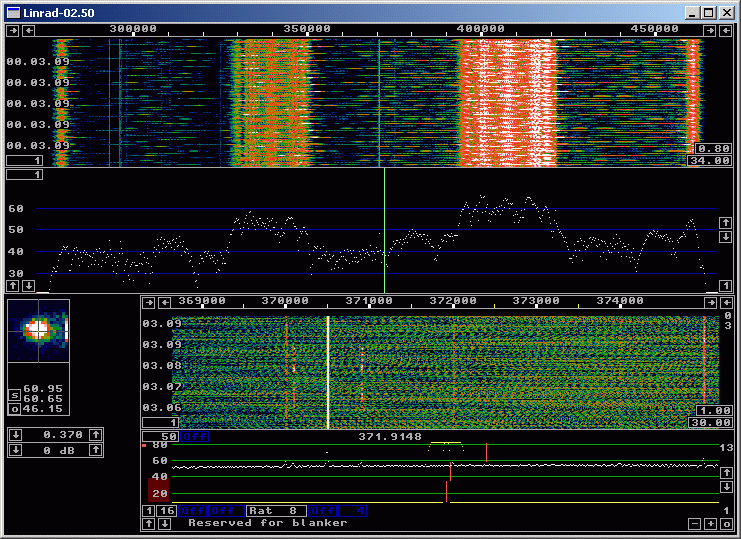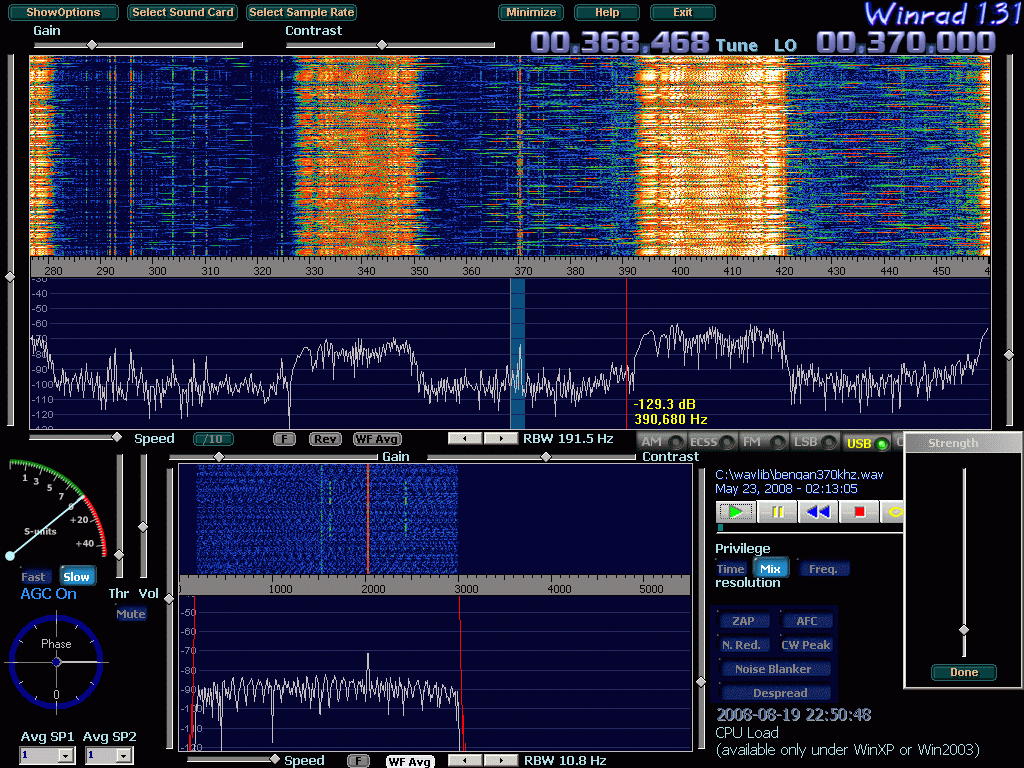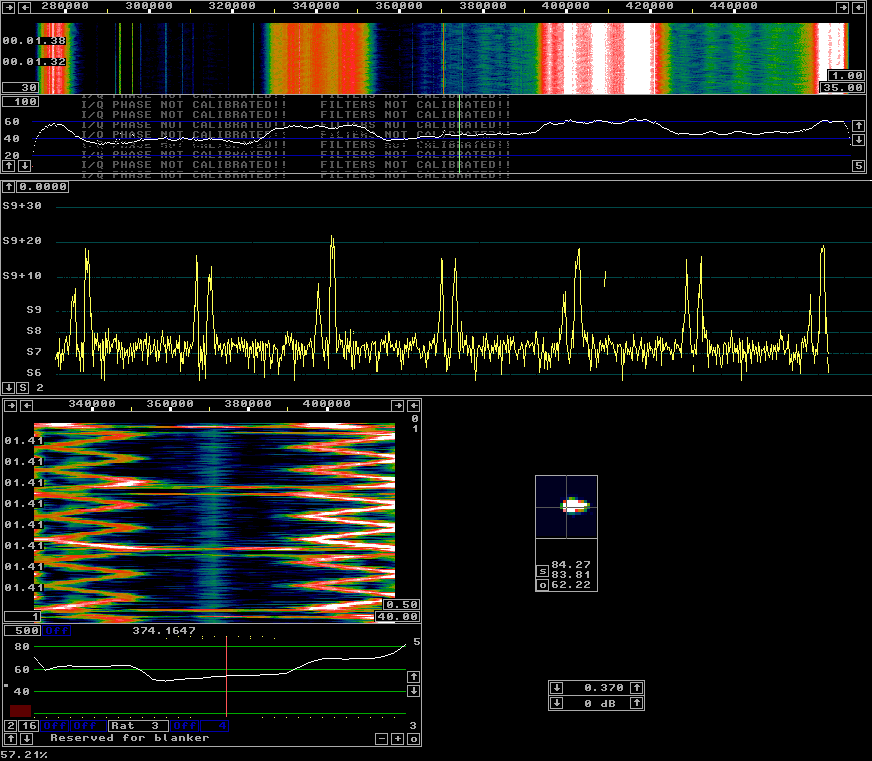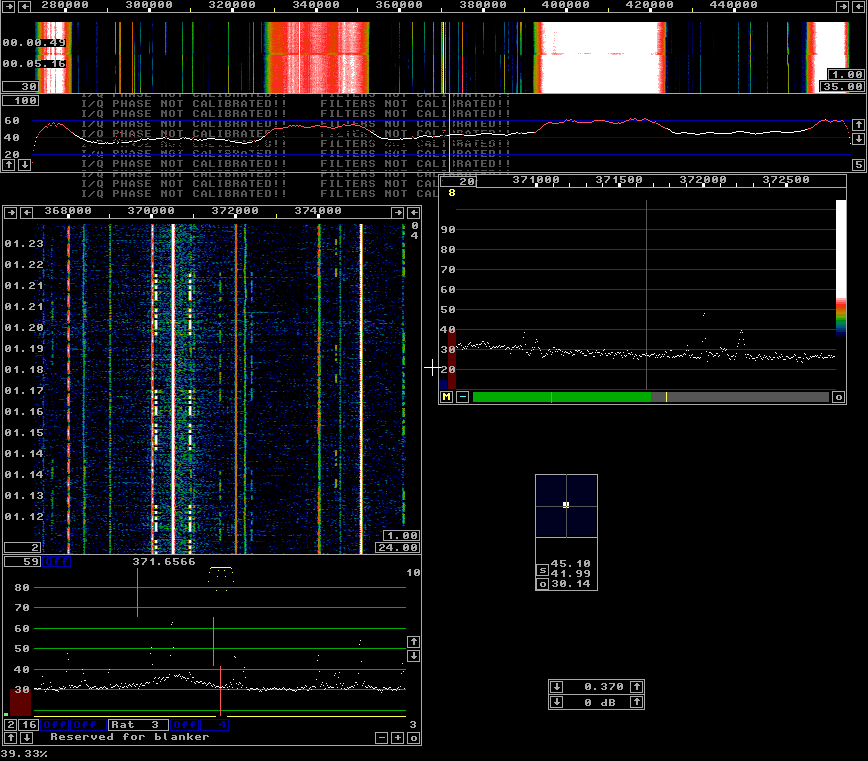
The recording.The file presented on this page, qrm370khz.wav (250003578 bytes) was recorded with an SDR-IQ on May 23, 2008, by Bengt Inge Bengtsson, Bengan in Falkenberg Sweden. The center frequency is 370 kHz with the NDB (non-directional beacon Angelholm LB visible at 370.5 kHz on the Spectravue screen. Figure 1. The zipped file can be downloaded here: http://sm5bsz.com/linuxdsp/usage/bengan/qrm370khz.zip (189025184 bytes)The antenna was an Aldo Loop mounted on the balcony of an apartment in an apartment house. The origin of the interference is unknown. |

|
|
Fig 1.The SpectraVue screen shows Angelholm,
LB at 370.5 kHz about 10 dB above the noise.
The distance is about Falkenberg Angelholm is about 70 km.
|
|
When running the file in Linrad with the same processing,
no noise blanker, no averaging in waterfall or spectrum display,
the visibility is very similar as expected.
Figure 2.
|

|
| Fig 2.The Linrad screen with the same processing in the main spectrum and waterfall as used with SpectraVue in figure 1. In the baseband spectrum and waterfall the resolution is much higher and one can crearly see the modulation sidebands LB around the carrier at 370.5 kHz. |
|
Winrad shows a similar screen, figure 3. An attempt to improve reception by use of the Winrad noise blanker did not help at all. At a normal setting, the blanker has no effect at all. Setting it more aggressive just degrades S/N of the signal. |

|
| Fig 3.The Winrad screen with similar processing as in figures 1 and 2. |
|
The above screen dumps do not convey much information about the nature of the interference. In Linrad one can set a high bandwidth for the baseband by selecting a high sampling rate for the loudspeaker output and by setting a small "First mixer bandwidth reduction." That allows a very fast baseband waterfall and S-meter graph as shown in figure 4. |

|
| Fig 4.Linrad with a high speed baseband waterfall graph and a fast S-meter. The sixth overtone of the interference is selected. |
|
The signal repeats every 68 kHz. The fundamental is at 68 kHz and the sixth overtone at 408 kHz is selected for loudspeaker output. The signal is frequency modulated with a triangular wave. The frequency swing is about 12 kHz at 408 kHz so the frequency swing of the fundamental is about 2 kHz. The modulation frequency of the triangular wave is about 270 Hz. The signal is also on/off keyed at 100 Hz with a duty cycle of about 90%. The associated keying sidebands fill the entire frequency range between successive overtones as can be seen in figure 5. |

|
| Fig 5.Linrad with a high speed baseband waterfall graph and a fast S-meter. The gap between the fifth and the sixth overtone is selected. |
|
The S-meter shows that the keying clicks (200 of them each second) are about 30 dB above the noise floor in a bandwidth of about 20 kHz. It is pretty obvious that a conventional noise blanker that operates in the full 196 kHz passband can not improve anything at all. Results with the Linrad noise blanker.With normal settings for the Linrad noise blanker, the screen looks like figure 6. The wide peaks corresponding to overtones of the interfering signal are all red in the main spectrum which means that those regions are excluded from the signal seen by the noise blanker.The smart blanker is useless in a situation like this, the pulse shapes are not determined by the frequency response of the RX hardware. The dumb blanker has reduced the noise floor around 370 kHz by about 25 dB. Besides the now strong LB one can easily see ODR Kristiansand, Norway at a distance of about 300 km. If you download the file and play with Linrad for a while you should be able to hear Ancona, Italy with the call sign ANC on 373.480 kHz (This is the lower sideband. The carrier is at 374.5 kHz.) The distance from Falkenberg to Ancona is about 1470 km. |

|
| Fig 6.Normal operation of the Linrad noise blanker. |
|
To SM 5 BSZ Main Page |